Eric Zhongcong Xu
HOSNeRF: Dynamic Human-Object-Scene Neural Radiance Fields from a Single Video
Apr 24, 2023Abstract:We introduce HOSNeRF, a novel 360{\deg} free-viewpoint rendering method that reconstructs neural radiance fields for dynamic human-object-scene from a single monocular in-the-wild video. Our method enables pausing the video at any frame and rendering all scene details (dynamic humans, objects, and backgrounds) from arbitrary viewpoints. The first challenge in this task is the complex object motions in human-object interactions, which we tackle by introducing the new object bones into the conventional human skeleton hierarchy to effectively estimate large object deformations in our dynamic human-object model. The second challenge is that humans interact with different objects at different times, for which we introduce two new learnable object state embeddings that can be used as conditions for learning our human-object representation and scene representation, respectively. Extensive experiments show that HOSNeRF significantly outperforms SOTA approaches on two challenging datasets by a large margin of 40% ~ 50% in terms of LPIPS. The code, data, and compelling examples of 360{\deg} free-viewpoint renderings from single videos will be released in https://showlab.github.io/HOSNeRF.
PV3D: A 3D Generative Model for Portrait Video Generation
Dec 13, 2022Abstract:Recent advances in generative adversarial networks (GANs) have demonstrated the capabilities of generating stunning photo-realistic portrait images. While some prior works have applied such image GANs to unconditional 2D portrait video generation and static 3D portrait synthesis, there are few works successfully extending GANs for generating 3D-aware portrait videos. In this work, we propose PV3D, the first generative framework that can synthesize multi-view consistent portrait videos. Specifically, our method extends the recent static 3D-aware image GAN to the video domain by generalizing the 3D implicit neural representation to model the spatio-temporal space. To introduce motion dynamics to the generation process, we develop a motion generator by stacking multiple motion layers to generate motion features via modulated convolution. To alleviate motion ambiguities caused by camera/human motions, we propose a simple yet effective camera condition strategy for PV3D, enabling both temporal and multi-view consistent video generation. Moreover, PV3D introduces two discriminators for regularizing the spatial and temporal domains to ensure the plausibility of the generated portrait videos. These elaborated designs enable PV3D to generate 3D-aware motion-plausible portrait videos with high-quality appearance and geometry, significantly outperforming prior works. As a result, PV3D is able to support many downstream applications such as animating static portraits and view-consistent video motion editing. Code and models will be released at https://showlab.github.io/pv3d.
Egocentric Video-Language Pretraining @ Ego4D Challenge 2022
Jul 04, 2022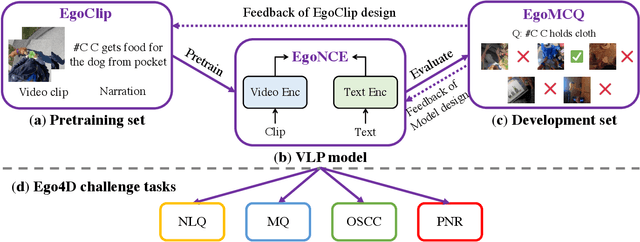
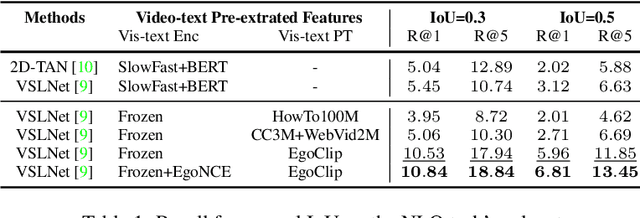

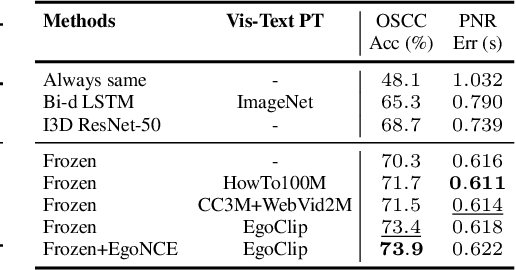
Abstract:In this report, we propose a video-language pretraining (VLP) based solution \cite{kevin2022egovlp} for four Ego4D challenge tasks, including Natural Language Query (NLQ), Moment Query (MQ), Object State Change Classification (OSCC), and PNR Localization (PNR). Especially, we exploit the recently released Ego4D dataset \cite{grauman2021ego4d} to pioneer Egocentric VLP from pretraining dataset, pretraining objective, and development set. Based on the above three designs, we develop a pretrained video-language model that is able to transfer its egocentric video-text representation or video-only representation to several video downstream tasks. Our Egocentric VLP achieves 10.46R@1&IoU @0.3 on NLQ, 10.33 mAP on MQ, 74% Acc on OSCC, 0.67 sec error on PNR. The code is available at https://github.com/showlab/EgoVLP.
Egocentric Video-Language Pretraining @ EPIC-KITCHENS-100 Multi-Instance Retrieval Challenge 2022
Jul 04, 2022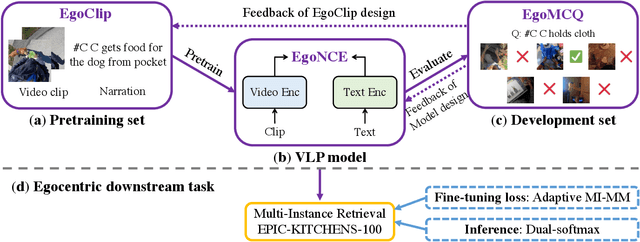
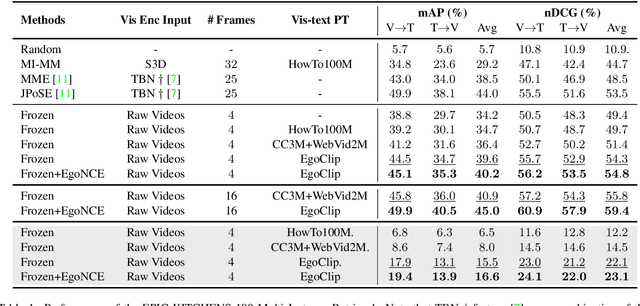
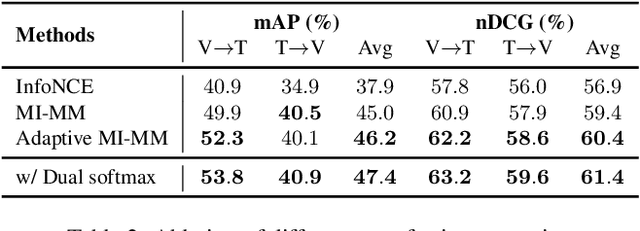
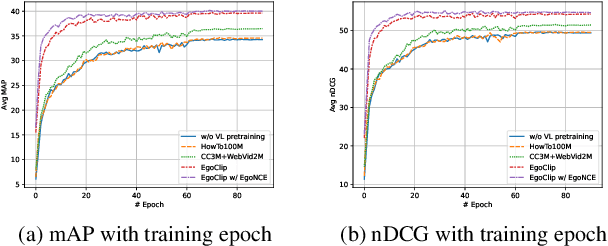
Abstract:In this report, we propose a video-language pretraining (VLP) based solution \cite{kevin2022egovlp} for the EPIC-KITCHENS-100 Multi-Instance Retrieval (MIR) challenge. Especially, we exploit the recently released Ego4D dataset \cite{grauman2021ego4d} to pioneer Egocentric VLP from pretraining dataset, pretraining objective, and development set. Based on the above three designs, we develop a pretrained video-language model that is able to transfer its egocentric video-text representation to MIR benchmark. Furthermore, we devise an adaptive multi-instance max-margin loss to effectively fine-tune the model and equip the dual-softmax technique for reliable inference. Our best single model obtains strong performance on the challenge test set with 47.39% mAP and 61.44% nDCG. The code is available at https://github.com/showlab/EgoVLP.
Egocentric Video-Language Pretraining
Jun 03, 2022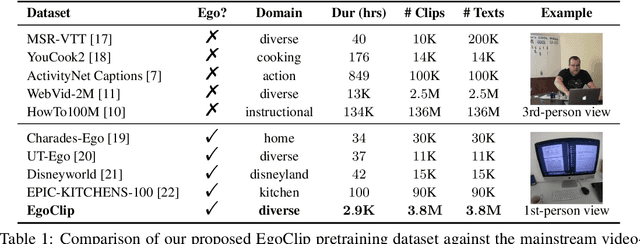
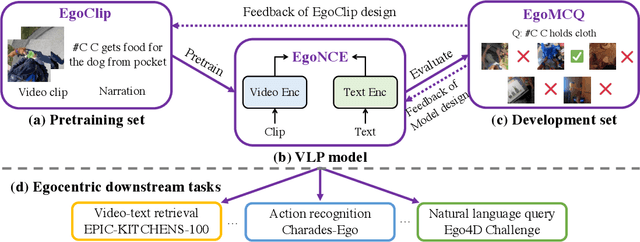
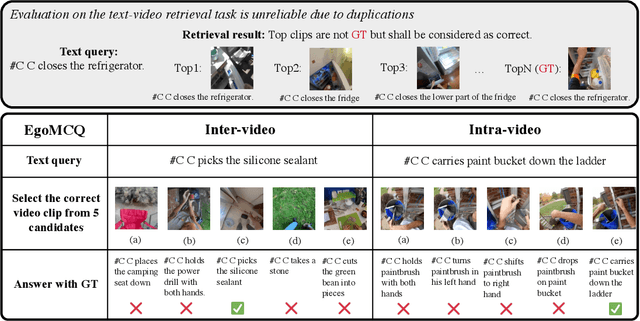

Abstract:Video-Language Pretraining (VLP), aiming to learn transferable representation to advance a wide range of video-text downstream tasks, has recently received increasing attention. Dominant works that achieve strong performance rely on large-scale, 3rd-person video-text datasets, such as HowTo100M. In this work, we exploit the recently released Ego4D dataset to pioneer Egocentric VLP along three directions. (i) We create EgoClip, a 1st-person video-text pretraining dataset comprising 3.8M clip-text pairs well-chosen from Ego4D, covering a large variety of human daily activities. (ii) We propose a novel pretraining objective, dubbed as EgoNCE, which adapts video-text contrastive learning to egocentric domain by mining egocentric-aware positive and negative samples. (iii) We introduce EgoMCQ, a development benchmark that is close to EgoClip and hence can support effective validation and fast exploration of our design decisions regarding EgoClip and EgoNCE. Furthermore, we demonstrate strong performance on five egocentric downstream tasks across three datasets: video-text retrieval on EPIC-KITCHENS-100; action recognition on Charades-Ego; and natural language query, moment query, and object state change classification on Ego4D challenge benchmarks. The dataset and code will be available at https://github.com/showlab/EgoVLP.
AVA-AVD: Audio-visual Speaker Diarization in the Wild
Dec 06, 2021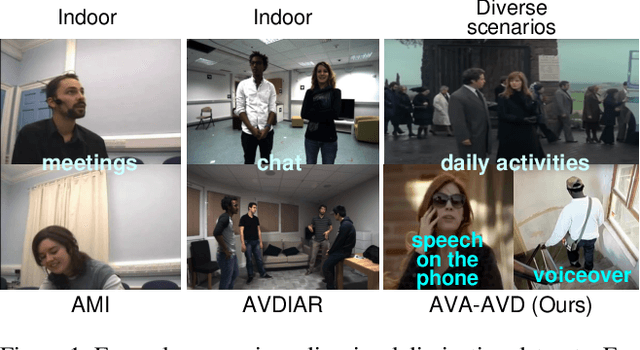


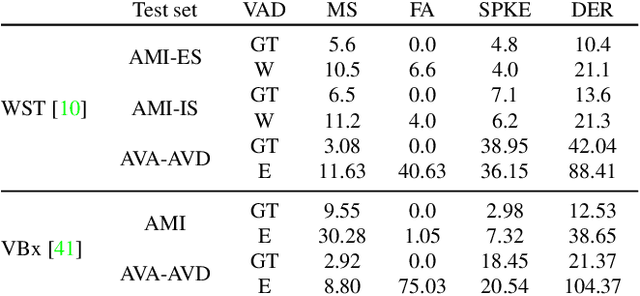
Abstract:Audio-visual speaker diarization aims at detecting ``who spoken when`` using both auditory and visual signals. Existing audio-visual diarization datasets are mainly focused on indoor environments like meeting rooms or news studios, which are quite different from in-the-wild videos in many scenarios such as movies, documentaries, and audience sitcoms. To create a testbed that can effectively compare diarization methods on videos in the wild, we annotate the speaker diarization labels on the AVA movie dataset and create a new benchmark called AVA-AVD. This benchmark is challenging due to the diverse scenes, complicated acoustic conditions, and completely off-screen speakers. Yet, how to deal with off-screen and on-screen speakers together still remains a critical challenge. To overcome it, we propose a novel Audio-Visual Relation Network (AVR-Net) which introduces an effective modality mask to capture discriminative information based on visibility. Experiments have shown that our method not only can outperform state-of-the-art methods but also is more robust as varying the ratio of off-screen speakers. Ablation studies demonstrate the advantages of the proposed AVR-Net and especially the modality mask on diarization. Our data and code will be made publicly available at https://github.com/zcxu-eric/AVA-AVD.
Ego4D: Around the World in 3,000 Hours of Egocentric Video
Oct 13, 2021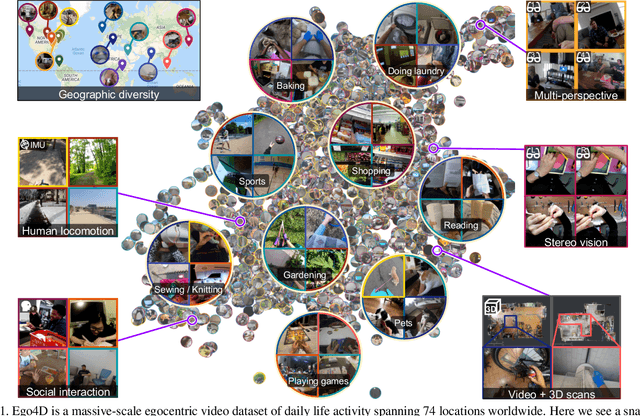
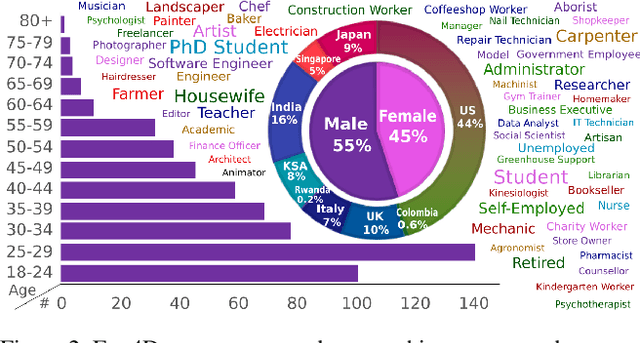

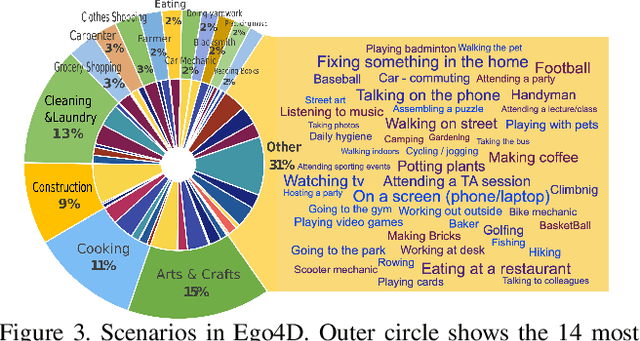
Abstract:We introduce Ego4D, a massive-scale egocentric video dataset and benchmark suite. It offers 3,025 hours of daily-life activity video spanning hundreds of scenarios (household, outdoor, workplace, leisure, etc.) captured by 855 unique camera wearers from 74 worldwide locations and 9 different countries. The approach to collection is designed to uphold rigorous privacy and ethics standards with consenting participants and robust de-identification procedures where relevant. Ego4D dramatically expands the volume of diverse egocentric video footage publicly available to the research community. Portions of the video are accompanied by audio, 3D meshes of the environment, eye gaze, stereo, and/or synchronized videos from multiple egocentric cameras at the same event. Furthermore, we present a host of new benchmark challenges centered around understanding the first-person visual experience in the past (querying an episodic memory), present (analyzing hand-object manipulation, audio-visual conversation, and social interactions), and future (forecasting activities). By publicly sharing this massive annotated dataset and benchmark suite, we aim to push the frontier of first-person perception. Project page: https://ego4d-data.org/
 Add to Chrome
Add to Chrome Add to Firefox
Add to Firefox Add to Edge
Add to Edge